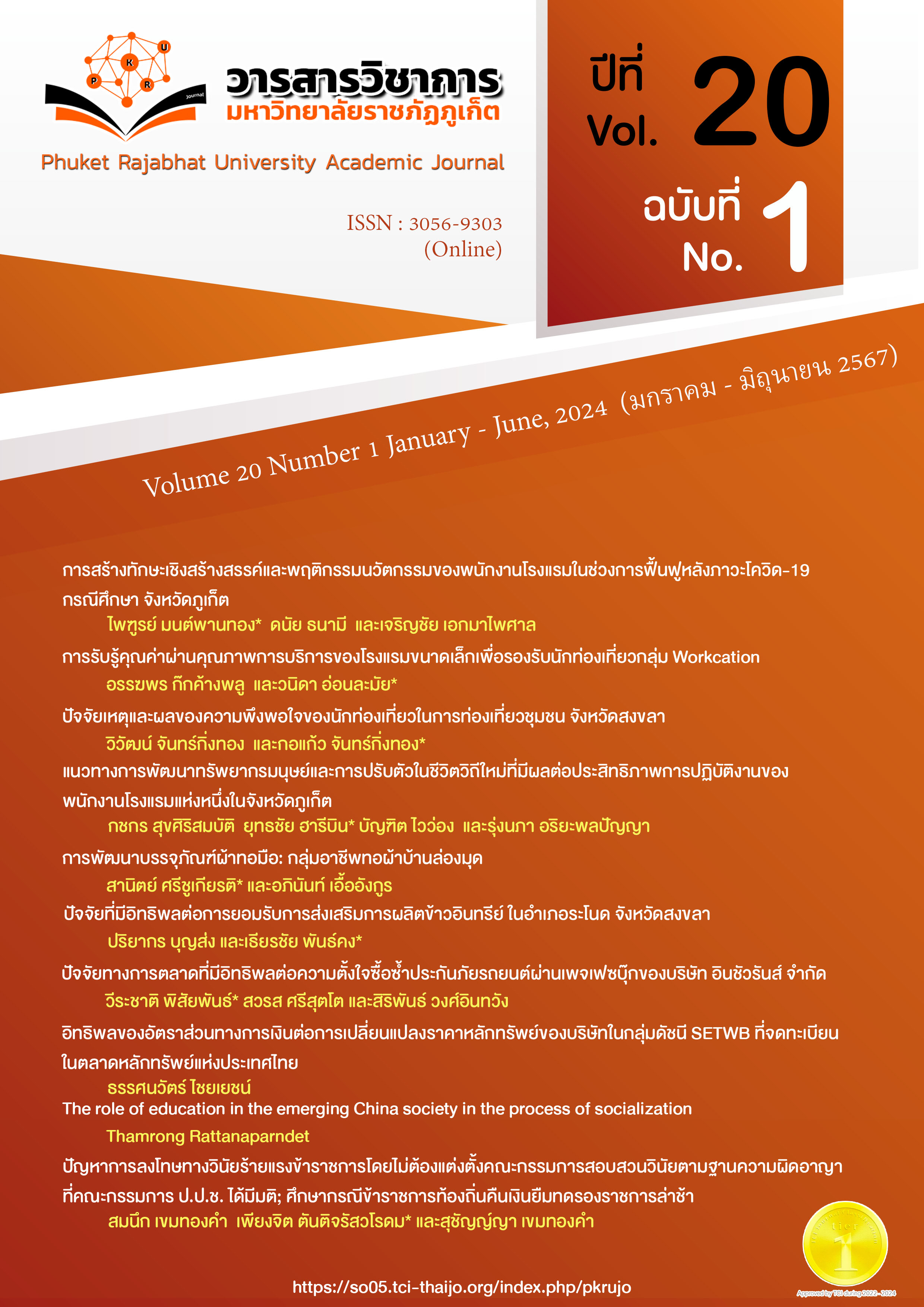การเปรียบเทียบการจัดการท่าเรือสำหรับเรือสำราญของประเทศไทยกับท่าเรือที่ได้มาตรฐานสากล
Main Article Content
บทคัดย่อ
การศึกษาครั้งนี้มีวัตถุประสงค์เพื่อเปรียบเทียบการจัดการท่าเรือหลักของประเทศไทยกับท่าเรือที่ได้มาตรฐานสากล โดยใช้ระเบียบวิธีวิจัยเชิงปริมาณ เก็บข้อมูลด้วยแบบสอบถามจากนักท่องเที่ยวชาวต่างชาติที่เดินทางมากับเรือสำราญและใช้บริการท่าเรือสำราญ ณ ท่าเรือแหลมฉบัง ท่าเรือภูเก็ต และท่าเรือสมุยที่มีการท่องเที่ยวบนฝั่ง จำนวน 450 คน โดยใช้การสุ่มตัวอย่างแบบเฉพาะเจาะจง (purposive sampling) สถิติที่ใช้ในการวิเคราะห์ข้อมูล ได้แก่ ค่าเฉลี่ย ส่วนเบี่ยงเบนมาตรฐาน ผลการวิจัย พบว่าปัจจัยด้านท่าเรือ โดยรวมอยู่ในระดับน้อย โดยแยกรายประเด็นย่อยของด้านท่าเรือ พบว่า ด้านความปลอดภัยของท่าเรือ อาคารผู้โดยสาร และโครงสร้างพื้นฐานของท่าเรือ อยู่ในระดับน้อย ในขณะที่ด้านการการบริการของท่าเรือ เปรียบเทียบระหว่างฝั่งประเทศไทย และฝั่งประเทศสิงคโปร์ การบริการของท่าเรือ พบว่า โดยรวมอยู่ในระดับน้อย โดยมีระยะเวลาในการให้บริการ อยู่ในระดับน้อย และคุณภาพการบริการของพนักงาน ด้านพิธีการเข้าเมืองอยู่ในระดับปานกลาง ตามลำดับ
Article Details

อนุญาตภายใต้เงื่อนไข Creative Commons Attribution-NonCommercial-NoDerivatives 4.0 International License.
เนื้อหาและข้อมูลในบทความที่ลงตีพิมพ์ในวารสารวิชาการมหาวิทยาลัยราชภัฏภูเก็ต ถือเป็นข้อคิดเห็นและความรับผิดชอบของผู้เขียนบทความโดยตรง ซึ่งกองบรรณาธิการวารสารฯ ไม่จำเป็นต้องเห็นด้วยหรือร่วมรับผิดชอบใด ๆ
บทความ ข้อมูล เนื้อหา รูปภาพ ฯลฯ ที่ได้รับการตีพิมพ์ในวารสารวิชาการมหาวิทยาลัยราชภัฏภูเก็ต ถือเป็นลิขสิทธิ์ของวารสารวิชาการมหาวิทยาลัยราชภัฏภูเก็ต หากบุคคลหรือหน่วยงานใดต้องการนำทั้งหมดหรือส่วนหนึ่งส่วนใดไปเผยแพร่ต่อหรือเพื่อกระทำการใด ๆ จะต้องได้รับอนุญาตเป็นลายลักษณ์อักษรจากวารสารวิชาการมหาวิทยาลัยราชภัฏภูเก็ตก่อนเท่านั้น
เอกสารอ้างอิง
Andriotis, K., & Agiomirgianakis, G. (2010). Cruise visitors' experience in a Mediterranean port of call. International Journal of Tourism Research, 12(4), 390-404.
Chua, B. L., Lee, S., & Han, H. (2017). Consequences of cruise line involvement: A comparison of first-time and repeat passengers. International Journal of Contemporary Hospitality Management, 29(6), 1658-1683.
CLIA. (2016). Cruise Lines International Association (CLIA) 2013 North America Cruise Industry Update. Report.
CLIA. (2020). The Economic Contribution of the International Cruise Industry Globally in 2019.
Douglas, N., & Douglas, N. (2004). Cruise ship passenger spending patterns in Pacific island ports. International Journal of Tourism Research, 6(4), 251-261.
European Commission. (2009). Tourist Facilities in Ports: The Economic Factor. Policy Research Corporation; p.1-65. CLIA. (2013).
Gibson, P. (2006). Cruise Operations Management. The Management of Hospitality and Tourism. Oxford: Elsevier.
Jordan, L. A. (2013). A critical assessment of Trinidad and Tobago as a cruise homeport: doorway to the South American cruise market?. Maritime Policy & Management, 40(4), 367-383.
Lekakou, M.B, Palli, A.A. and Vaggelas, K. G. (2009). Is this a home-port? An analysis of Cruise’s industry’s selection criteria. Department of Shipping Transport & Trade, University of Aegean, Greece, p.1-18.
Monpanthong, P. (2018). Efficiency of cruise port management: A comparison of
Pallis, A. A., Vitsounis, T. K., De Langen, P. W., & Notteboom, T. E. (2011). Port Economics, Policy and Management Content Classification and Survey. Transport Reviews, 31(4), 445-471.
Phuket and Singapore. Pertanika Journal of Social Sciences & Humanities, 26(4).
Ramkissoon, H., & Nunkoo, R. (2011). City Image and Perceived Tourism Impact: Evidence from Port Louis, Mauritius. International Journal of Hospitality & Tourism Administration, 12(2), 123-143.
Satta, G., Parola, F., Penco, L., & Persico, L. (2015). Word of mouth and satisfaction in cruise port destinations. Tourism Geographies, 17(1), 54-75.
Singapore, M. B. C. C. (2015). Marina Bay Cruise Centre Singapore Celebrates Fifth Anniversary. Retrieved from www.seatrade-cruise.com
Thurau, B., Seekamp, E., Carver, A. D., & Lee, J. G. (2015). Should Cruise Ports Market Ecotourism? A Comparative Analysis of Passenger Spending Expectations within the Panama Canal Watershed. International Journal of Tourism Research, 17(1), 45-53.
UNWTO. (2016). Sustainable Cruise Tourism Development Strategies - Tackling the Challenges in Itinerary Design in South-East Asia. Madrid: World Tourism Organization.


